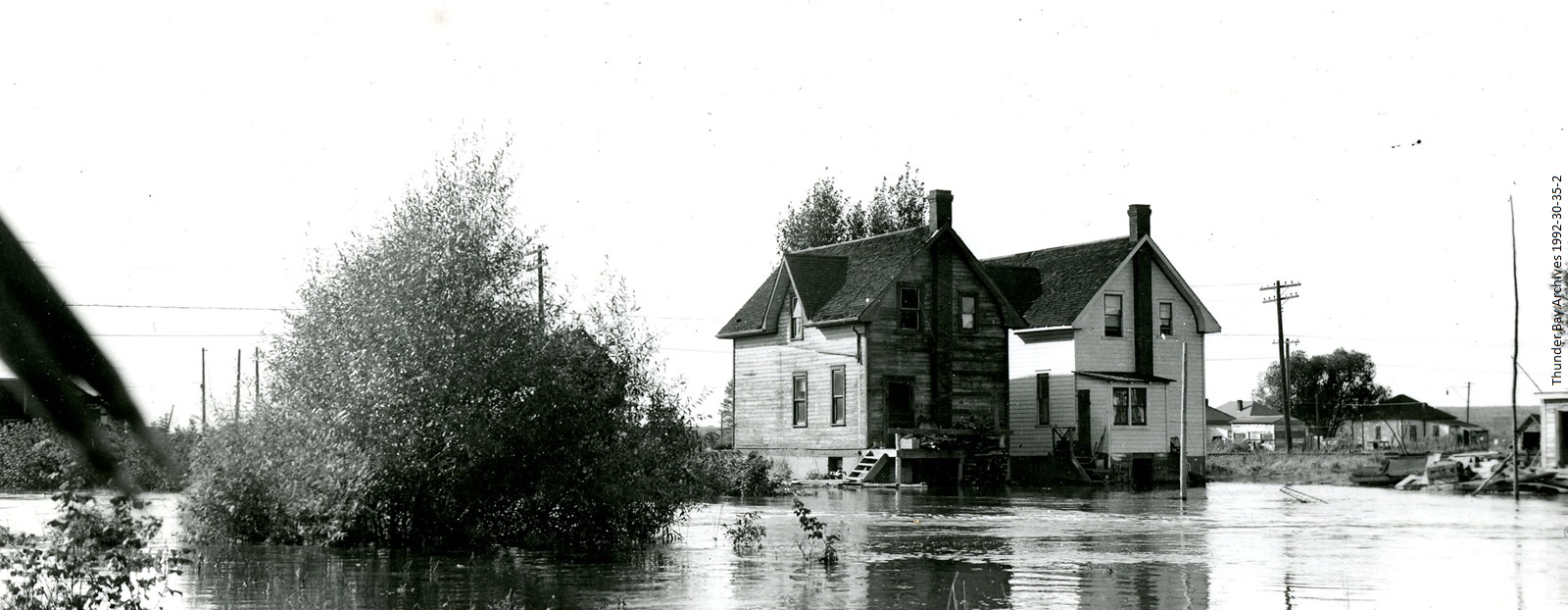While the cold war played out between the United States and the Soviet Union, Fort William and Port Arthur sat at the centre of continental shipping and right beside North America's largest fresh water supply. Canada allied itself with other Western nations through organizations such as NATO (the North Atlantic Treaty Organization) and worked with the United States on military defences through NORAD (the North American Aerospace Defense Command).
Strategies were needed to keep Thunder Bay's citizens and other Canadians safe in the event of any type of nuclear attack. Throughout the 1960's, information was distributed in the form of pamphlets and books, describing ways to survive nuclear attacks, protect oneself from nuclear fallout, and how to obtain and organize proper emergency supplies.
The Aircraft Detection Corps in the Lakehead
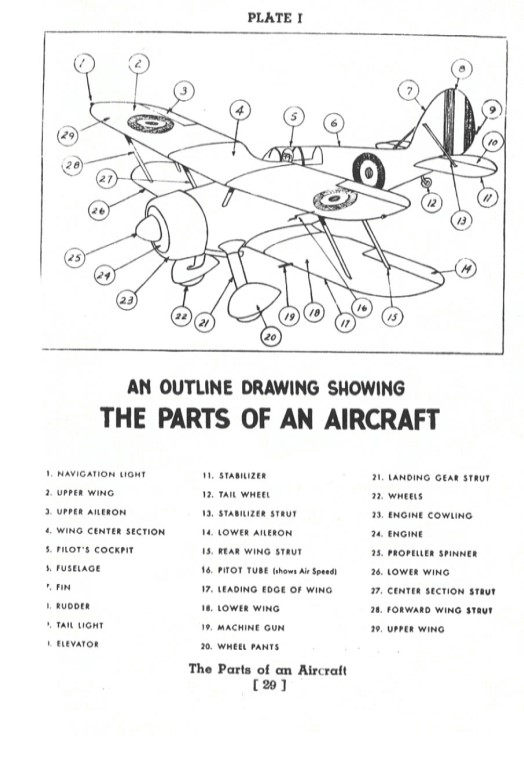
Figure 1. Plate I
AN OUTLINE DRAWING SHOWING
THE PARTS OF AN AIRCRAFT
1. Navigation Light 16. Pilot Tube (shows Air Speed)
2. Upper Wing 17. Leading Edge of Wing
3. Upper Aileron 18. Lower Wing
4. Wing Center Section 19. Machine Gun
5. Pilot's Cockpit 20. Wheel Pants
6. Fuselage 21. Landing Gear Strut
7. Fin 22. Wheels
8. Rudder 23. Engine Cowling
9. Tail Light 24. Engine
10. Elevator 25. Propeller Spinner
11. Stabilizer 26. Lower Wing
12. Tail Wheel 27. Center Section Strut
13. Stabilizer Strut 28. Forward Wing Strut
14. Lower Aileron 29. Upper Wing
15. Rear Wing Strut
The Parts of an Aircraft
[ 29 ]
World War II and Threats to the Lakehead
During World War II, the cities of Fort William and Port Arthur were the home of the Bombardier plane manufacturing plant. This meant they were threatened by enemy aircraft. The Royal Canadian Air force partnered with Bell Telephone Company and Canadian National Telegraph, set up air raid siren towers and observation posts to keep the cities safe.1
In 1943, D.W. Ferrier, the General Traffic Manager for the R.C.A.F, contacted the Public Utilities Commission in Port Arthur to arrange an area of Port Arthur that the Aircraft Detection Corps (A.D.C.) would operate out of and the system in which they would operate. 2 The A.D.C. was a group of mainly volunteer civilians whose job was to report on any enemy aircraft or vessels seen around the Lakehead during World War II.3 Observation posts were set up in strategic areas of Port Arthur and detection handbooks were given to observers to know how and when to send over reports to Fort William, then from there reported to Winnipeg for action.4
Observation posts covered 124.3 kilometres and each separate one was identified by a specific code name, such as “Baffin 10”.5 The observers were all given handbooks that would aid them in identifying potential threats, including information like aircraft markings and shapes, to the cities but these handbooks were also given to all the assisting telephone company offices so they could also make a report when needed.6
Along with having A.D.C. observers, Fort William and Port Arthur also served as distribution centres, receiving and sending calls in a radius of 141.6 kilometres.7 The Bell Telephone Company and Canadian National Telegraph would have connection points, at Kaministiquia, Sunshine, Shabaqua, Shebandowan, along with connections to Cameron Falls by radio.8 With the help of radio circuits ran by the Hydro-Electric Power Commission in Cameron Falls, long distance calls were also sent from Beardmore, Geraldton, and Long Lac, allowing more reports to be sent from Fort William to the Winnipeg regiments for documentation and action.9
Conclusion
No major attack did ever hit the two cities, but the procedures that were put in place were ready to keep the Lakehead safe if there ever was a threat, and sometimes even if there wasn’t.
Footnotes:
Additional Images
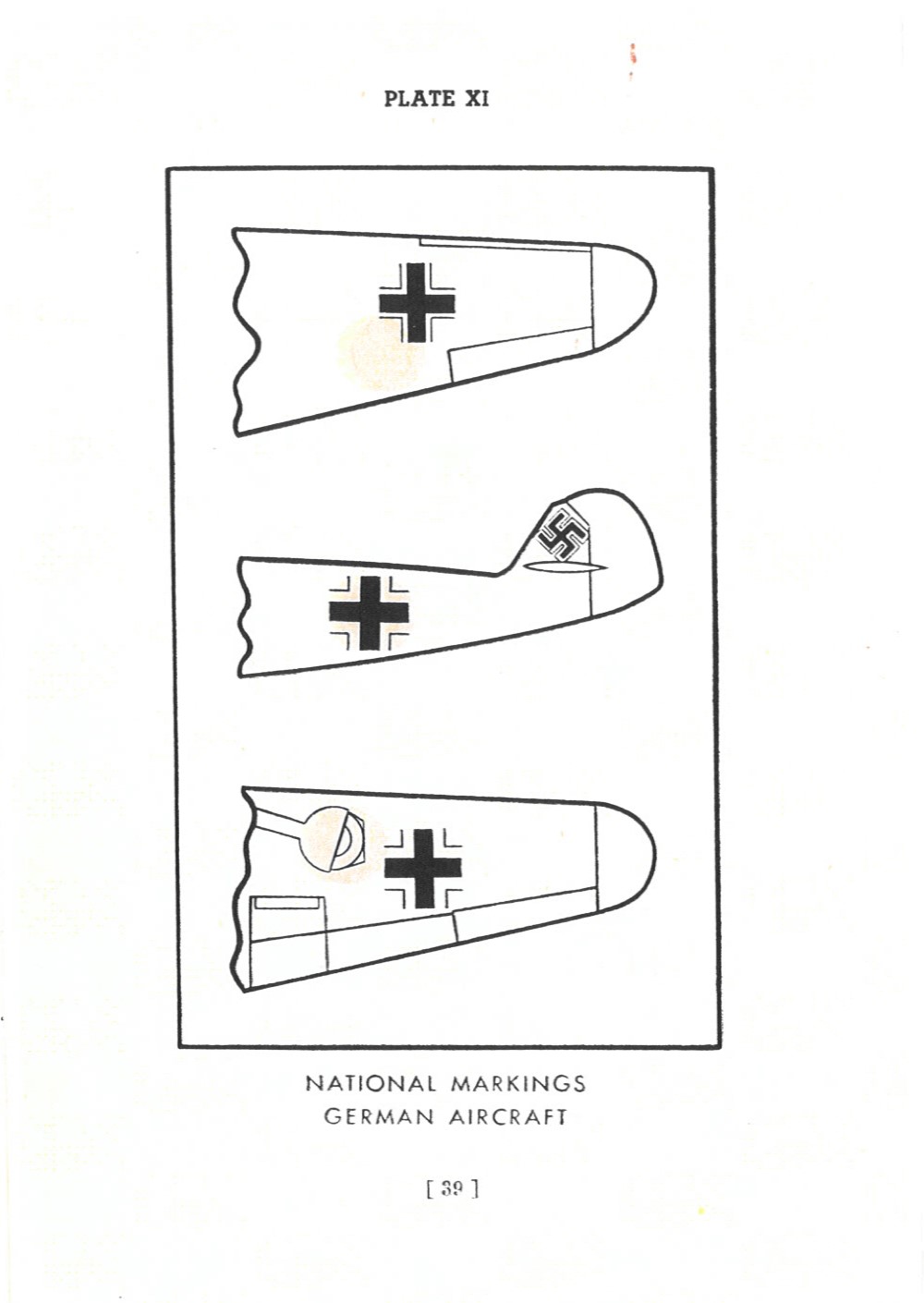
Figure 2. PLATE XI
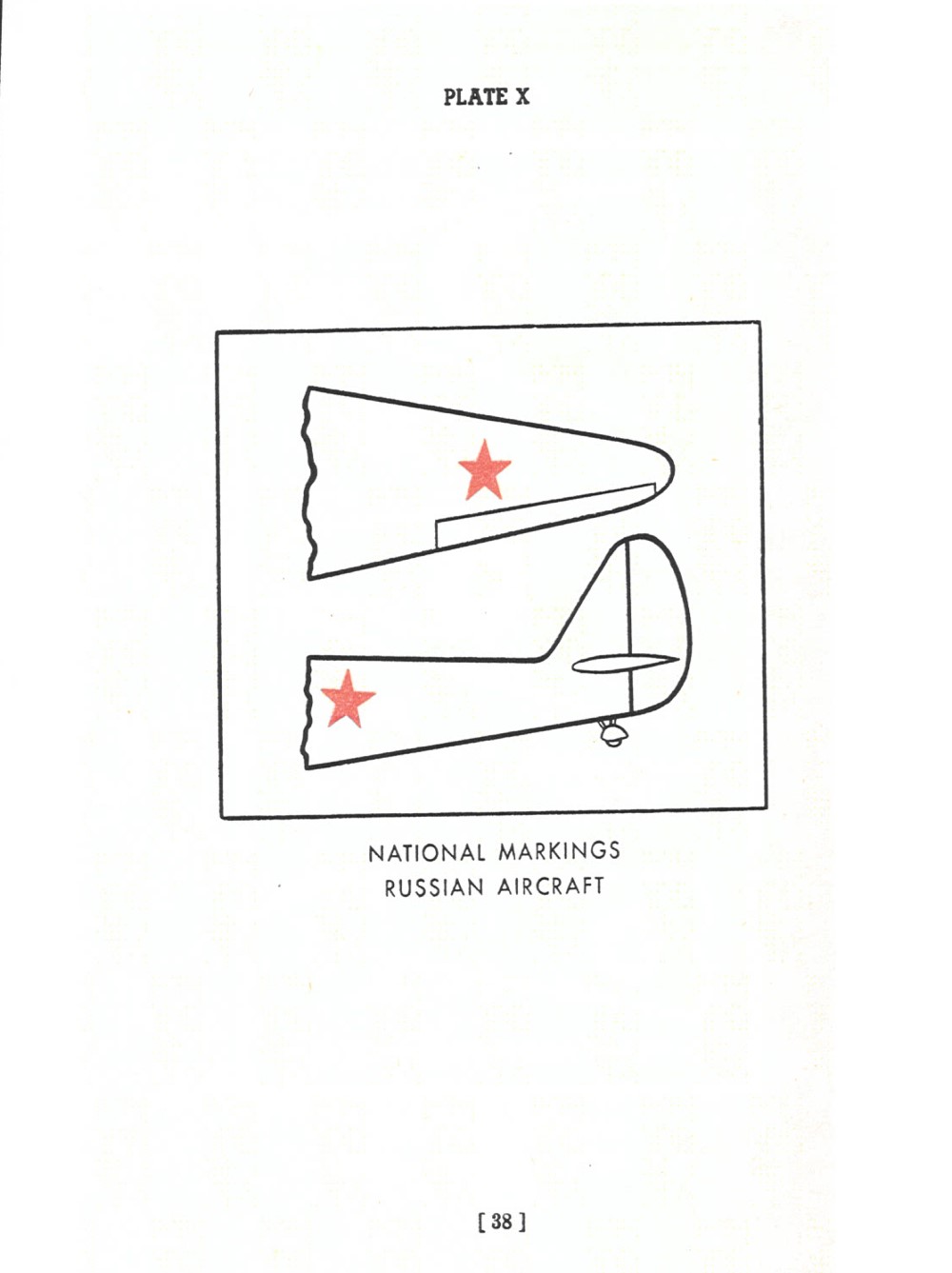

National Markings
German Aircraft
[ 39 ]
Figure 3. PLATE X
National Markings
Russian Aircraft
[ 38 ]
Figure 4. ROYAL CANADIAN AIR FORCE
AIRCRAFT DETECTION CORPS
SPECIAL INFORMATION TO TELEPHONE OPERATORS
1. The Aircraft Detection corps of the Royal Canadian Air Force has been formed to provide prompt and reliable reports to our Defence Forces of the approach of hostile aircraft. Its personnel consists of volunteer civilian observers, who forward these reports through the normal communication facilities of the country.
2. Your company has patriotically granted the use of their facilities on a priority basis, to transmit these reports. However, the success of the plan depends on the speed and accuracy with which the reports are handled between the observer and the Defence Forces, and this link in the chain in the telephone operator.
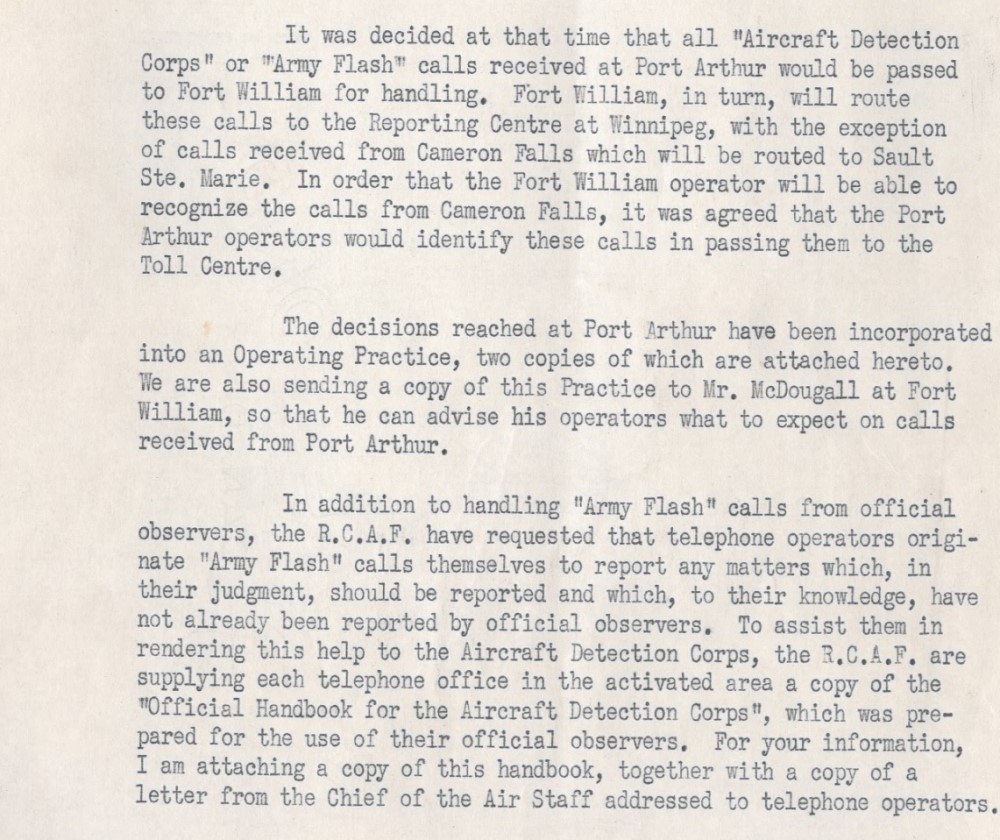
Figure 5. It was decided at that time that all "Aircraft Detection Corps" or "Army Flash" calls received at Port Arthur would be passed to Fort William for handling. Fort William, in turn, will route these calls to the Reporting Centre at Winnipeg, with the exception of calls received from Cameron Falls which will be routed to Sault Ste. Marie. In order that the Fort William operator will be able to recognize the calls from Cameron Falls, it was agreed that the Port Arthur operators would identify these calls in passing them to the Toll Centre.
The decisions reached at Port Arthur have been incorporated in an Operating Practice, two copies of which are attached hereto. We are also sending a copy of this Practice to Mr. Mcdougall at Fort William, so that he can advise his operators what to expect on calls received from Port Arthur.
In addition to handling "Army Flash" calls from official observers, the R.C.A.F. have requested that telephone operators originate "Army Flash" calls themselves to report any matters which, in their judgement, should be reported and which, to their knowledge, have not already been reported by official observers. To assist them in rendering this help to the Aircraft Detection Corps, the R.C.A.F. are supplying each telephone office in the activated area a copy of the "Official Handbook for Aircraft Detection Corps", which was prepared for the use of their official observers. For your information, I am attaching a copy of this handbook, together with a letter from the Chief of Air Staff addressed to telephone operators.
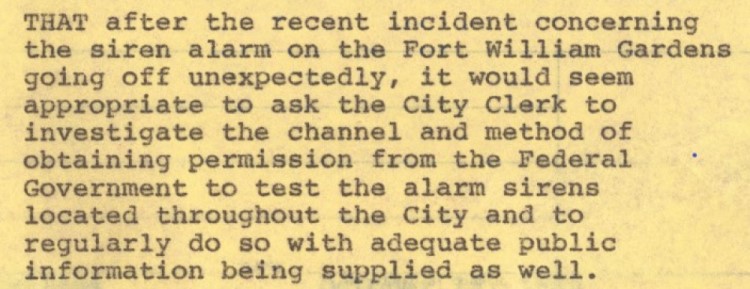 Figure 6. THAT after the recent incident concerning the siren alarm on the Fort William Gardens going off unexpectedly, it would seem appropriate to ask the City Clerk to investigate the channel and method of obtaining permission from the Federal Government to test the alarm sirens located throughout the City and to regularly do so with adequate public information being supplied as well.
Figure 6. THAT after the recent incident concerning the siren alarm on the Fort William Gardens going off unexpectedly, it would seem appropriate to ask the City Clerk to investigate the channel and method of obtaining permission from the Federal Government to test the alarm sirens located throughout the City and to regularly do so with adequate public information being supplied as well.
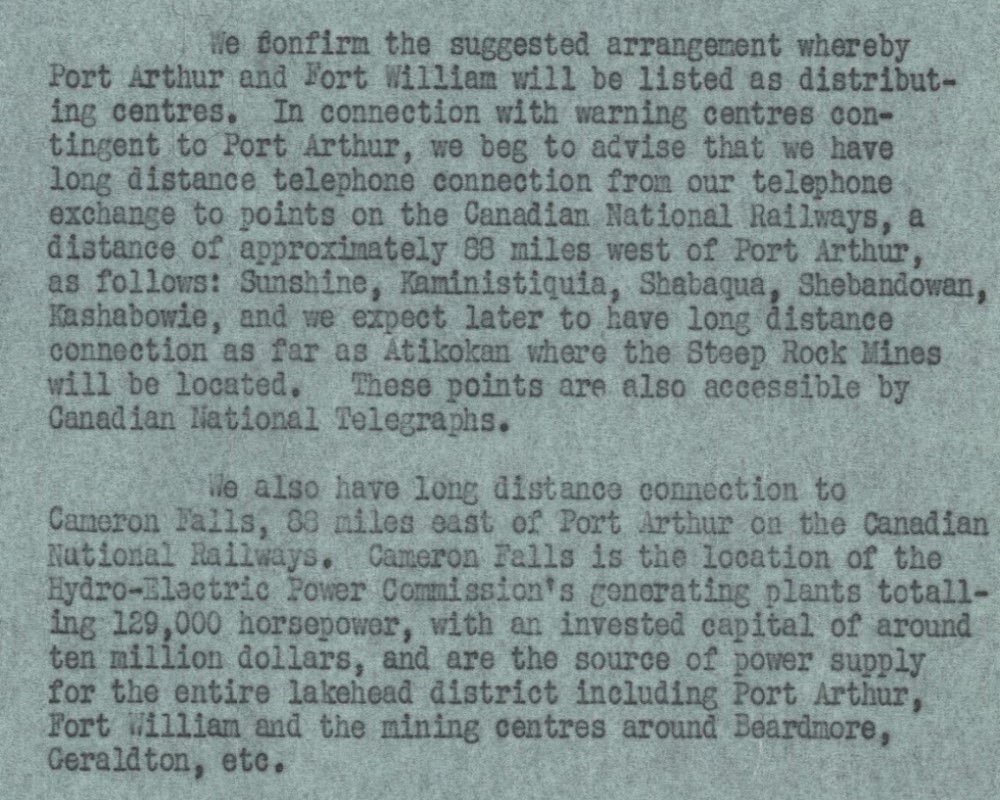
Figure 7. We confirm the suggested arrangement whereby Port Arthur and Fort William will be listed as distributing centres. In connection with warning centres contingent to Port Arthur, we beg to advise that we have long distance telephone points on the Canadian National Railways, a distance of approximately 88 miles west of Port Arthur, as follows: Sunshine, Kaministiquia, Shabaqua, Shebandowan, Kashabowie, and we expect later to have have long distance connection as far as Atikokan where the Steep Rock Mines will be located. These points are also accessible by Canadian National Telegraphs.
We also have long distance connection to Cameron Falls, 88 miles east of Port Arthur on the Canadian National Railways. Cameron Falls is the location of the Hydro-Electric Power Commission's generating plants totalling 129,000 horsepower, with an invested capital of around ten million dollars and are the source of power supply for the entire Lakehead district including Port Arthur, Fort William and the mining centres around Beardmore, Geraldton, etc.
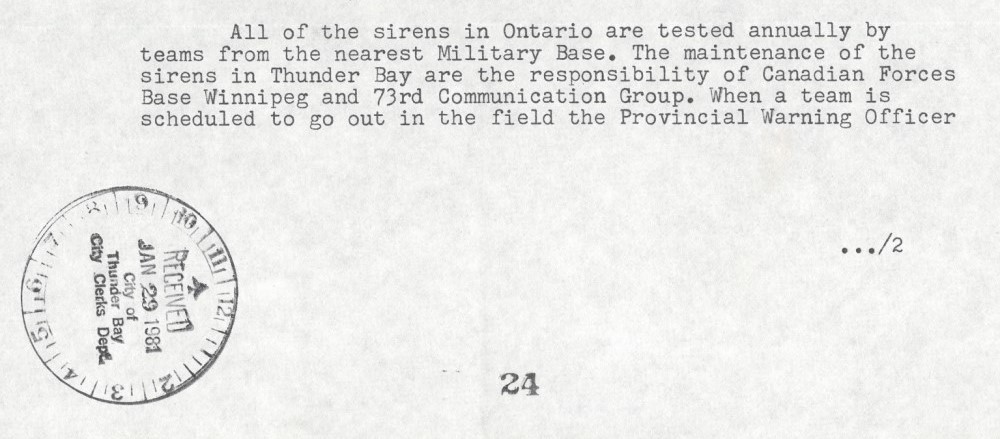
Figure 8. All of the sirens in Ontario are tested annually by teams from the nearest Military Base. The maintenance of the sirens in Thunder Bay are the responsibility of Canadian Forces Base Winnipeg and 73rd Communication Group. When a team is scheduled to go out in the field the Provincial Warning Officer (continues in Figure 9).
Stamp in lower left reads: RECEIVED / Jan 29, 1981 / City of / Thunder Bay / City Clerks Dept.
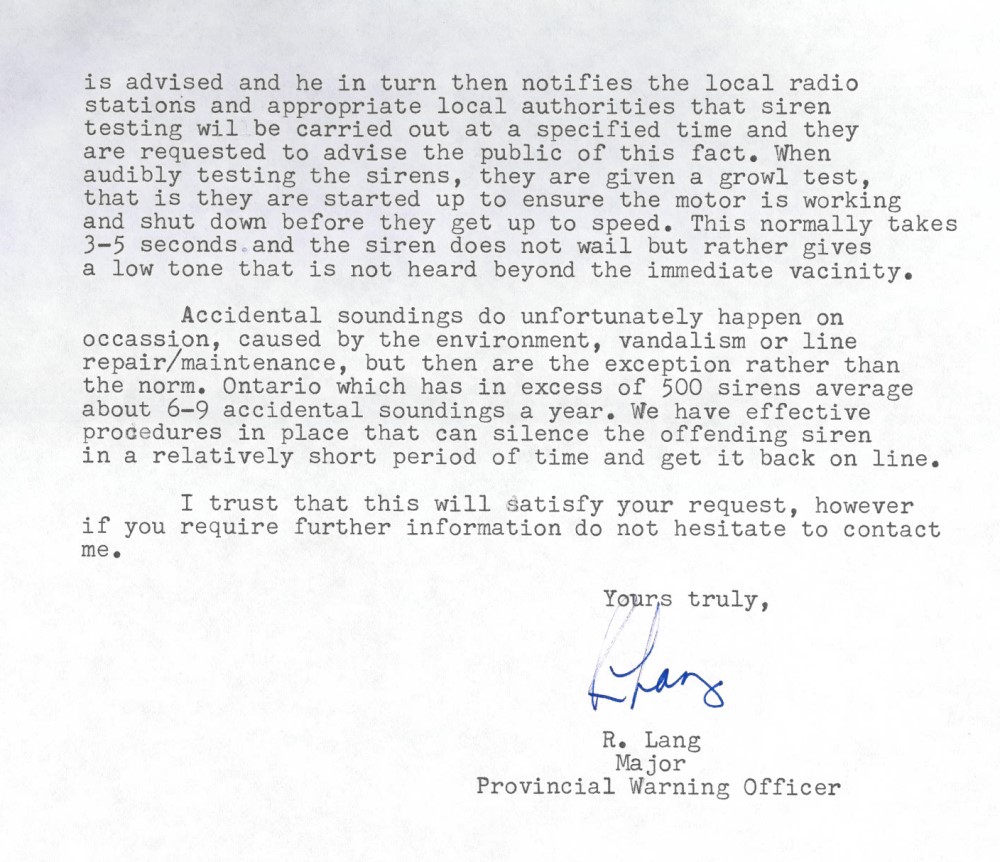 Figure 9. is advised and he in turn then notifies the local radio stations and appropriate local authorities that siren testing will be carried out at a specified time and they are requested to advise the public of this fact. When audibly testing the sirens, they are given a growl test, that is they are started up to ensure the motor is working and shut down before they get up to speed. This is normally takes 3-5 seconds and the siren does not wail but rather gives a low tone that is not heard beyond the immediate vicinity.
Figure 9. is advised and he in turn then notifies the local radio stations and appropriate local authorities that siren testing will be carried out at a specified time and they are requested to advise the public of this fact. When audibly testing the sirens, they are given a growl test, that is they are started up to ensure the motor is working and shut down before they get up to speed. This is normally takes 3-5 seconds and the siren does not wail but rather gives a low tone that is not heard beyond the immediate vicinity.
Accidental soundings do unfortunately happen on occasion, caused by the environment, vandalism or line repair/maintenance, but then are the exception rather than the norm. Ontario which has in excess of 500 sirens average about 6-9 accidental soundings a year. We have effective procedures in place that can silence the offending siren in a relatively short period of time and get it back on line.
I trust that this will satisfy your request, however if you require further information do not hesitate to contact me.
Yours Truly / R. Lang / Major / Provincial Warning Officer
Contact Us


